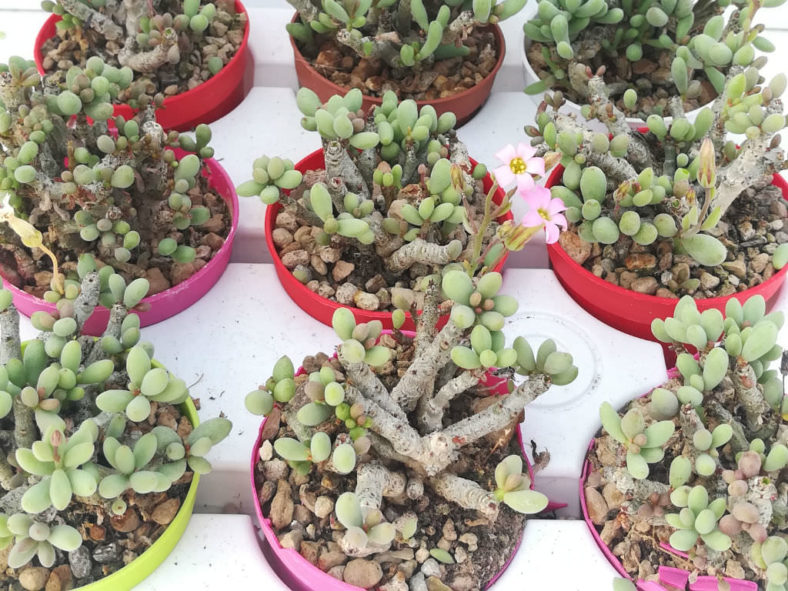Tylecodon is a genus of about 45 species of succulent plants in the family Crassulaceae, restricted to the winter rainfall region of South Africa and Namibia. They occur quite abundantly in habitats ranging from rocky coastal shores to rock crevices in mountainous terrain to sandy, hilly terrain.
All species were formerly included in the genus Cotyledon. In 1978, Helmut Toelken split them into a genus of their own.
The generic name "Tylecodon" is an anagram of the original genus Cotyledon.
Tylecodons range in size from the giant Tylecodon paniculatus, up to 8.2 feet (2.5 m) tall, to the miniatures like Tylecodon occultans, which rarely gets more than an inch (2.5 cm) above ground. In habitat, Tylecodons are deciduous, losing their leaves in summer, while Cotyledons are evergreen. In cultivation, it is usually, but not always, the same and depends somewhat on cultivation practices. The leaves may persist longer on the plants if they are watered. Tylecodons have spirally arranged leaves, while Cotyledons have leaves arranged in opposite pairs. Flowers appear in the spring or summer after the plants shed their leaves. There are a few geophytic Tylecodon species. They protect themselves, hidden underground, from animals and drought during the dry season.

Growing Conditions for Tylecodon
Tylecodons can be easily grown outdoors in winter rainfall areas in warm to temperate regions where frost is not severe. The dwarf species are better suited to growing in pots as indoor or greenhouse plants.
Light
These succulents can withstand direct sunlight without problems, but they grow beautifully in partial shade.
Soil
A well-draining soil mix is a key to healthy Tylecodon. Poor drainage and overwatering are the most common causes of root rot in both indoor and outdoor plants. Indoors, it is essential to use pots with at least one drainage hole at the bottom.
Temperature
These plants are highly tolerant of high temperatures. They are also tolerant of cold, frost-free conditions during the winter. Tylecodons are winter growers. They will look their best during the colder months and shrink or drop leaves entirely during the summer. Tylecodons can tolerate cold down to USDA hardiness zone 9b, with a minimum temperature of 25°F (-3.9°C).
General Care for Tylecodon
Tylecodons are easy to care for and perfect for beginners.
Watering
As winter growers, Tylecodons require careful watering during winter and spring. Get the soil wet, then wait until it dries before watering again. In summer, reduce watering to once per month.
Fertilizing
Use liquid fertilizer for cacti and other succulents during the winter months.
Repotting
You do not need to repot these plants often. You can do it when the container becomes too small or shallow.
How to Propagate Tylecodon
Tylecodons can be cultivated from seed or cuttings.
Seeds
Growing Tylecodons from seed is a long process. Sow the seeds in fall and winter in a seedbox with a well-draining potting mix. After sowing, cover the seeds with coarse sand. Keep the soil moist until the seeds germinate. Once seeds sprout, water once a week during winter and once a month in summer. After about two years, the seedlings will be about 0.8 to 1.2 inches (2 to 3 cm) tall and can be pricked out and planted in pots.
Cuttings
The best time to take cuttings is in the fall. Select cutting material, let it callus for about 2 weeks, and then place the cuttings in a well-draining soil mix. You can grow them in a temporary container while they establish roots, or plant them directly in a permanent pot. Until the cuttings form roots, water them frequently enough to keep the soil from drying out. They usually take about one year to develop a strong root system.
Pests and Diseases of Tylecodon
These succulents are relatively free of diseases and pests.
Toxicity of Tylecodon
Tylecodons are adapted to avoid animal predation by being poisonous. Some are highly toxic to livestock, and farmers in South Africa routinely remove every Tylecodon they find. Keep them away from children, pets, and livestock. It is best to wear gloves when handling Tylecodon.
Links
- Back to genus Tylecodon
- Succupedia: Browse succulents by Scientific Name, Common Name, Genus, Family, USDA Hardiness Zone, Origin, or cacti by Genus